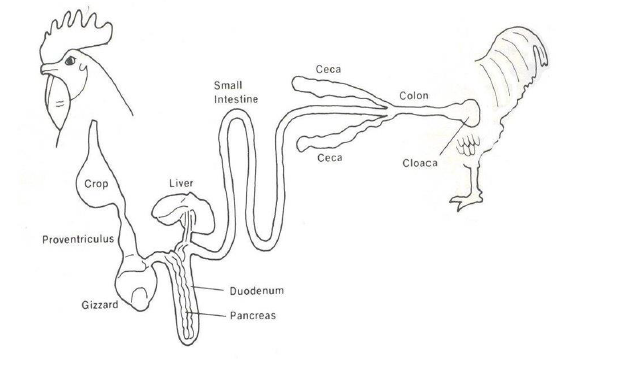
Mouth Parts
The fowl has no lips and teeth. Instead it has a horny mandible on each jaw, forming the beak. The tongue has barb-like projections at the back which are important in forcing the grain towards the gullet when the tongue is moved from front to back. Saliva production in the mouth is very minimal.
Esophagus
It has an enormous capacity to expand. Food passes from the mouth through the esophagus to the crop and onwards.
Crop
It is an enlargement of the esophagus. It is used for storing and softening the food. Food is gradually sent to the stomach by contraction of the walls of the crop.
Proventriculus
It is an enlarged muscular portion of the esophagus. It is a small organ which receives food from the crop. Various glands open into its inner surface. The glands secrete gastric juice and some acids. These liquids are mixed with the food and assist in further softening of the food.
Gizzard
It is a heavily muscled reddish-green organ located caudal to proventriculus. Its principal function is the crushing and grinding of food. It is the largest single organ of the body. It is composed of two pairs of thick powerful muscles covered internally with a thick horny epithelium. It acts as a filter allowing fine material to proceed to duodenum, while coarse material are retained for longer periods to be ground by the contractions of the gizzard.
Duodenum
It represents the first part of small intestine which forms a fold immediately the digestive canal leaves the gizzard. The loop or fold of duodenum supports the pancreas. Gastric digestion together with some pancreatic digestion takes place in the duodenum.
Pancreas
It lies between the folds of duodenum. The pancreas is longer in birds than in mammals. It secretes pancreatic juice that contains proteolytic, amylolytic and lipolytic enzymes which hydrolyse proteins, starches and fats. Pancreatic juice empties into the duodenum.
Liver
It is a large multi-lobed dark-red organ. It is the largest gland in the body. It secretes bile. Two ducts convey the bile from the liver to the terminal part of duodenum. The one from the right lobe of liver is enlarged to form the gall bladder in which the bile is temporarily stored. The one from the left lobe has no such enlargement. The two ducts enter the duodenum together. The gall bladder is dark-green in color. Bile aids in the digestion of fat.
Small Intestine
It extends from gizzard to caeca. In mature bird it is about 2.5 feet long. The inner surface is lined by villi. The small intestine has both digestive and absorptive function.
Caeca
They are two blind sacs 5-7 inches long and situated at junction between small and large intestines. They open into the intestine as one. They serve as temporary storage organs for fecal material, and some absorption may take place in them. They also aid in fiber digestion.
Large Intestine
It lies between the junction between of caeca and extends for a short distance up to the exterior opening of the cloaca. Short villi project into the lumen of the tract for further absorption of the digested material. [in mammals villi are absent in the large intestine]
Cloaca
Fecal material from large intestine and urine from kidneys pass into this organ. The materials are mixed and excreted through the vent.
sharon kalunda answered the question on
February 25, 2019 at 13:56